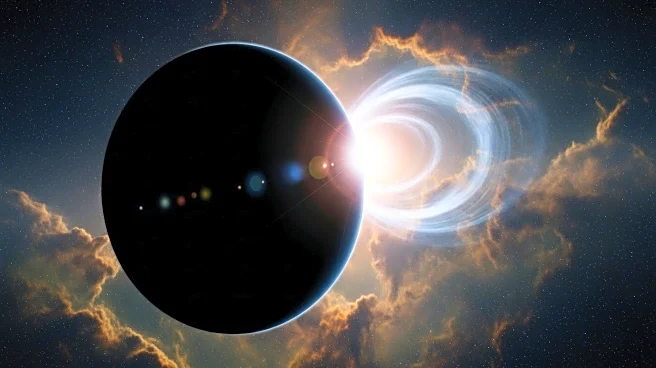What is the story about?
What's Happening?
Astronomers have identified a rogue planet, Cha 1107-7626, consuming material at an extraordinary rate, using the James Webb Space Telescope and the Very Large Telescope in Chile. This object, located 620 light-years away in the Chameleon constellation, is absorbing 6 billion metric tons of material per second. Despite its planetary mass, the object exhibits characteristics similar to young stars, such as having an accretion disk and a magnetic field guiding inflowing gas. This discovery marks the first time such activity has been observed in a planetary-mass object, challenging the traditional distinctions between planets and stars.
Why It's Important?
The discovery of Cha 1107-7626 blurs the line between planets and stars, offering new insights into the formation and evolution of celestial bodies. This finding could reshape our understanding of planetary formation, suggesting that some planets may form in isolation like stars. The study of such objects can provide valuable information about the processes that govern the birth and growth of planets and stars, potentially impacting theories in astrophysics and cosmology. The ability to observe these phenomena with advanced telescopes like the JWST and VLT highlights the technological advancements in space exploration.
What's Next?
The research team plans to continue monitoring Cha 1107-7626 to understand the frequency and nature of its accretion bursts. Future studies will focus on the chemistry of the object's disks and atmospheres, which could reveal more about its formation and evolution. The ongoing observations may also help determine whether such bursts are common among similar rogue planets, providing further insights into their origins and characteristics.
Beyond the Headlines
This discovery raises questions about the classification of celestial bodies and the processes that lead to their formation. The existence of rogue planets like Cha 1107-7626 challenges the conventional understanding of planetary systems, suggesting that some planets may not require a host star to form. This could lead to a reevaluation of the criteria used to define planets and stars, influencing future astronomical research and exploration.
AI Generated Content
Do you find this article useful?
















